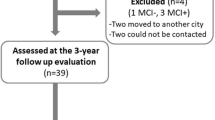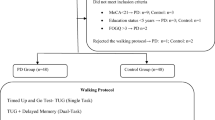Abstract
The interplay between gait and specific cognitive faculties, in particular executive function (EF) and dual tasking abilities, has been described in healthy adults and in patients with Parkinson’s disease (PD). There is, however, little direct evidence on the relationship between cognitive function, gait, and fall risk in PD, especially in the “ON” state (i.e., under the influence of the anti-parkinsonian medications). To address this issue, we evaluated cognitive function and gait under usual walking and dual-task conditions in 30 patients with PD in the ON state of the medication cycle. Subjects were classified as fallers or non-fallers based on their history. A computerized battery quantified cognitive function. Gait was assessed under three conditions: (1) Usual walking, (2) While subtracting serial 3 s, and (3) While subtracting serial 7 s. The EF and attention scores were lower in the fallers, compared to non-fallers (P ≤ 0.037), but general measures of cognition, e.g., memory, (P = 0.341) were not. Gait speed, variability, and the bilateral coordination of gait were worse in the fallers in all conditions. The DT effects on gait variability and bilateral coordination were larger in the fallers (P = 0.044, P = 0.061, respectively). These results suggest that patients with PD who have a high risk of falling are more sensitive to DT effects, perhaps as a result of relatively poor EF. These cognitive and motor deficits may increase the likelihood of loss of balance during everyday attention-demanding tasks among patients with PD.

Similar content being viewed by others
References
Adkin AL, Frank JS, Jog MS (2003) Fear of falling and postural control in Parkinson’s disease. Mov Disord 18:496–502
Alexander NB, Hausdorff JM (2008) Linking thinking, walking, and falling. J Gerontol A Biol Sci Med Sci 63:1325–1328
Allcock LM, Rowan EN, Steen IN, Wesnes K, Kenny RA, Burn DJ (2009) Impaired attention predicts falling in Parkinson’s disease. Parkinsonism Relat Disord 15:110–115
Baltadjieva R, Giladi N, Gruendlinger L, Peretz C, Hausdorff JM (2006) Marked alterations in the gait timing and rhythmicity of patients with de novo Parkinson’s disease. Eur J Neurosci 24:1815–1820
Bloem BR, Hausdorff JM, Visser JE, Giladi N (2004) Falls and freezing of gait in Parkinson’s disease: a review of two interconnected, episodic phenomena. Mov Disord 19:871–884
Brauer SG, Morris ME (2010) Can people with Parkinson’s disease improve dual tasking when walking? Gait Posture 31:229–233
Camicioli R, Oken BS, Sexton G, Kaye JA, Nutt JG (1998) Verbal fluency task affects gait in Parkinson’s disease with motor freezing. J Geriatr Psychiatry Neurol 11:181–185
Cheng EM, Tonn S, Swain-Eng R, Factor SA, Weiner WJ, Bever CT Jr (2010) Quality improvement in neurology: AAN Parkinson disease quality measures: report of the quality measurement and reporting subcommittee of the American academy of neurology. Neurology 75:2021–2027
Coppin AK, Shumway-Cook A, Saczynski JS, Patel KV, Ble A, Ferrucci L, Guralnik JM (2006) Association of executive function and performance of dual-task physical tests among older adults: analyses from the InChianti study. Age Ageing 35:619–624
Doniger GM, Zucker DM, Schweiger A, Dwolatzky T, Chertkow H, Crystal H, Simon ES (2005) Towards practical cognitive assessment for detection of early dementia: a 30-minute computerized battery discriminates as well as longer testing. Curr Alzheimer Res 2:117–124
Doniger GM, Dwolatzky T, Zucker DM, Chertkow H, Crystal H, Schweiger A, Simon ES (2006) Computerized cognitive testing battery identifies mild cognitive impairment and mild dementia even in the presence of depressive symptoms. Am J Alzheimers Dis Other Demen 21:28–36
Dwolatzky T, Whitehead V, Doniger GM, Simon ES, Schweiger A, Jaffe D, Chertkow H (2003) Validity of a novel computerized cognitive battery for mild cognitive impairment. BMC Geriatr 3:4
Dwolatzky T, Whitehead V, Doniger GM, Simon ES, Schweiger A, Jaffe D, Chertkow H (2004) Validity of the Mindstreams computerized cognitive battery for mild cognitive impairment. J Mol Neurosci 24:33–44
Fahn S, Elton R, Members of the UPDRS Developmental Committee (1987) Unified Parkinson’s disease rating scale. In: Fahn S (ed) Recent developments in Parkinson’s disease. MacMillan Healthcare Information, Florham Park, pp 153–163
Folstein MF, Folstein SE, McHugh PR (1975) “Mini-mental state”. A practical method for grading the cognitive state of patients for the clinician. J Psychiatr Res 12:189–198
Gelb DJ, Oliver E, Gilman S (1999) Diagnostic criteria for Parkinson disease. Arch Neurol 56:33–39
Hackney ME, Earhart GM (2009) The effects of a secondary task on forward and backward walking in Parkinson’s disease. Neurorehabil Neural Repair. [Epub ahead of print]
Hausdorff JM (2009) Gait dynamics in Parkinson’s disease: common and distinct behavior among stride length, gait variability, and fractal-like scaling. Chaos 19:026113
Hausdorff JM, Cudkowicz ME, Firtion R, Wei JY, Goldberger AL (1998) Gait variability and basal ganglia disorders: stride-to-stride variations of gait cycle timing in Parkinson’s disease and Huntington’s disease. Mov Disord 13:428–437
Hausdorff JM, Rios D, Edelberg HK (2001) Gait variability and fall risk in community-living older adults: a 1-year prospective study. Arch Phys Med Rehabil 82:1050–1056
Hausdorff JM, Balash J, Giladi N (2003a) Effects of cognitive challenge on gait variability in patients with Parkinson’s disease. J Geriatr Psychiatry Neurol 16:53–58
Hausdorff JM, Schaafsma JD, Balash Y, Bartels AL, Gurevich T, Giladi N (2003b) Impaired regulation of stride variability in Parkinson’s disease subjects with freezing of gait. Exp Brain Res 149:187–194
Hausdorff JM, Doniger GM, Springer S, Yogev G, Giladi N, Simon ES (2006) A common cognitive profile in elderly fallers and in patients with Parkinson’s disease: the prominence of impaired executive function and attention. Exp Aging Res 32:411–429
Hely MA, Morris JG, Traficante R, Reid WG, O’Sullivan DJ, Williamson PM (1999) The sydney multicentre study of Parkinson’s disease: progression and mortality at 10 years. J Neurol Neurosurg Psychiatry 67:300–307
Herman T, Mirelman A, Giladi N, Schweiger A, Hausdorff JM (2010) Executive control deficits as a prodrome to falls in healthy older adults: a prospective study linking thinking, walking, and falling. J Gerontol A Biol Sci Med Sci 65:1086–1092
Hoehn MM, Yahr MD (1967) Parkinsonism: onset, progression and mortality. Neurology 17:427–442
Kalron A, Dvir Z, Achiron A (2010) Walking while talking–difficulties incurred during the initial stages of multiple sclerosis disease process. Gait Posture 32:332–335
Kerr GK, Worringham CJ, Cole MH, Lacherez PF, Wood JM, Silburn PA (2010) Predictors of future falls in Parkinson disease. Neurology 75:116–124
Latt MD, Lord SR, Morris JG, Fung VS (2009a) Clinical and physiological assessments for elucidating falls risk in Parkinson’s disease. Mov Disord 24:1280–1289
Latt MD, Menz HB, Fung VS, Lord SR (2009b) Acceleration patterns of the head and pelvis during gait in older people with Parkinson’s disease: a comparison of fallers and nonfallers. J Gerontol A Biol Sci Med Sci 64:700–706
Menant JC, St George RJ, Fitzpatrick RC, Lord SR (2010) Impaired depth perception and restricted pitch head movement increase obstacle contacts when dual-tasking in older people. J Gerontol A Biol Sci Med Sci 65:751–757
Mirelman A, Gurevich T, Giladi N, Bar-Shira A, Orr-Urtreger A, Hausdorff JM (2011) Gait alterations in healthy carriers of the LRRK2 G2019S mutation. Ann Neurol (in press)
Mirelman A, Maidan I, Herman T, Deutsch J, Giladi N, Hausdorff JM (2011) Virtual reality for gait training: can it induce motor learning to enhance complex walking and reduce fall risk in patients with Parkinson’s disease? J Gerontol Med Sci 66:234–240
Pickering RM, Grimbergen YA, Rigney U, Ashburn A, Mazibrada G, Wood B, Gray P, Kerr G, Bloem BR (2007) A meta-analysis of six prospective studies of falling in Parkinson’s disease. Mov Disord 22:1892–1900
Plotnik M, Giladi N, Balash Y, Peretz C, Hausdorff JM (2005) Is freezing of gait in Parkinson’s disease related to asymmetric motor function? Ann Neurol 57:656–663
Plotnik M, Giladi N, Hausdorff JM (2007) A new measure for quantifying the bilateral coordination of human gait: effects of aging and Parkinson’s disease. Exp Brain Res 181:561–570
Plotnik M, Dagan Y, Gurevich T, Giladi N, Hausdorff JM (2011) Effects of cognitive function on gait and dual tasking abilities in patients with Parkinson’s disease suffering from motor response fluctuations. Exp Brain Res 208:169–179
Plummer-D’Amato P, Altmann LJ, Saracino D, Fox E, Behrman AL, Marsiske M (2008) Interactions between cognitive tasks and gait after stroke: a dual task study. Gait Posture 27:683–688
Podsiadlo D, Richardson S (1991) The timed “Up & Go”: a test of basic functional mobility for frail elderly persons. J Am Geriatr Soc 39:142–148
Rochester L, Hetherington V, Jones D, Nieuwboer A, Willems AM, Kwakkel G, Van Wegen G (2005) The effect of rhythmical cues on walking during a simple and dual functional motor task in a complex environment in people with Parkinson’s disease. Arch Phys Med Rehabil 86:999–1006
Sato Y, Fujimatsu Y, Kikuyama M, Kaji M, Oizumic K (1998) Influence of immobilization on bone mass and bone metabolism in hemiplegic elderly patients with a long-standing stroke. J Neurol Sci 156:205–210
Sheridan PL, Hausdorff JM (2007) The role of higher-level cognitive function in gait: executive dysfunction contributes to fall risk in Alzheimer’s disease. Dement Geriatr Cogn Disord 24:125–137
Spielberger C, Gorusch R (1983) Self-evaluation questionnaire (form Y). Manual for the State-Trait Anxiety Inventory
Springer S, Giladi N, Peretz C, Yogev G, Simon ES, Hausdorff JM (2006) Dual-tasking effects on gait variability: the role of aging, falls, and executive function. Mov Disord 21:950–957
van der Bootsma WA, Gussekloo J, de Craen AJ, van Exel E, Bloem BR, Westendorp RG (2003) Walking and talking as predictors of falls in the general population: the Leiden 85-plus study. J Am Geriatr Soc 51:1466–1471
van Iersel MB, Kessels RP, Bloem BR, Verbeek AL, Olde Rikkert MG (2008) Executive functions are associated with gait and balance in community-living elderly people. J Gerontol A Biol Sci Med Sci 63:1344–1349
Verghese J, Holtzer R, Lipton RB, Wang C (2009) Quantitative gait markers and incident fall risk in older adults. J Gerontol A Biol Sci Med Sci 64:896–901
Yang YR, Chen YC, Lee CS, Cheng SJ, Wang RY (2007) Dual-task-related gait changes in individuals with stroke. Gait Posture 25:185–190
Yesavage JA, Brink TL, Rose TL, Lum O, Huang V, Adey M, Leirer VO (1982) Development and validation of a geriatric depression screening scale: a preliminary report. J Psychiatr Res 17:37–49
Yogev G, Giladi N, Peretz C, Springer S, Simon ES, Hausdorff JM (2005) Dual tasking, gait rhythmicity, and Parkinson’s disease: which aspects of gait are attention demanding? Eur J Neurosci 22:1248–1256
Yogev G, Plotnik M, Peretz C, Giladi N, Hausdorff JM (2007) Gait asymmetry in patients with Parkinson’s disease and elderly fallers: when does the bilateral coordination of gait require attention? Exp Brain Res 177:336–346
Yogev-Seligmann G, Hausdorff JM, Giladi N (2008) The role of executive function and attention in gait. Mov Disord 23:329–342
Yogev-Seligmann G, Rotem-Galili Y, Mirelman A, Dickstein R, Giladi N, Hausdorff JM (2010) How does explicit prioritization alter walking during dual-task performance? Effects of age and sex on gait speed and variability. Phys Ther 90:177–186
Acknowledgments
We thank the patients and staff of the Movement Disorders Unit at the Tel Aviv Sourasky Medical Center for invaluable assistance. We thank Dr. Jennifer Srygley and Mr. Leor Grundlinger for their help with data handling. This study was supported in part by grants from the Tel Aviv Sourasky Medical Center Grant of Excellence, by the Parkinson’s disease Foundation (PDF), the National Parkinson’s Foundation (NPF) and by the Israeli Ministries of Health and Veteran Affairs (Grant #3000004385). M. Plotnik acknowledges Dr. Jay Goldberg for inspiring his scientific work.
Author information
Authors and Affiliations
Corresponding author
Rights and permissions
About this article
Cite this article
Plotnik, M., Giladi, N., Dagan, Y. et al. Postural instability and fall risk in Parkinson’s disease: impaired dual tasking, pacing, and bilateral coordination of gait during the “ON” medication state. Exp Brain Res 210, 529–538 (2011). https://doi.org/10.1007/s00221-011-2551-0
Received:
Accepted:
Published:
Issue Date:
DOI: https://doi.org/10.1007/s00221-011-2551-0




